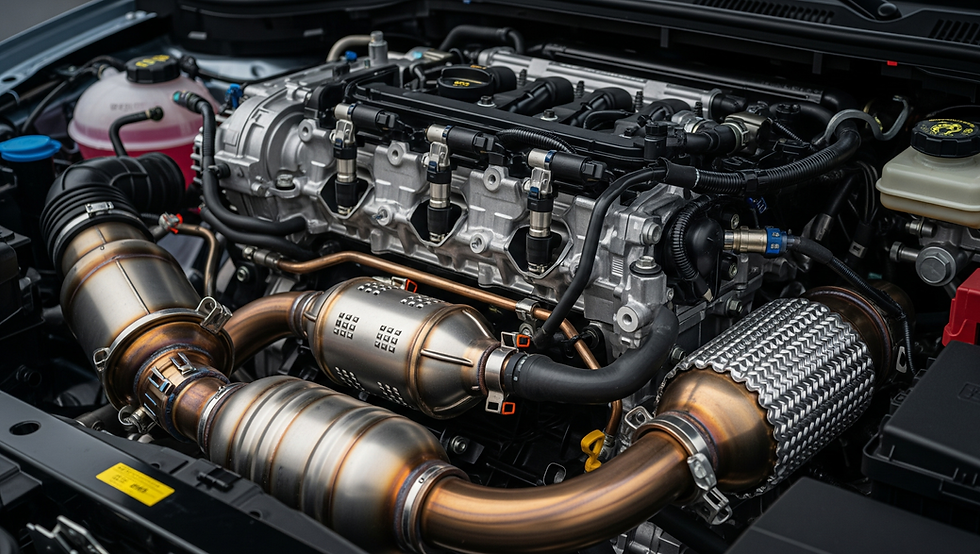Future Trends in Diesel Engines for On-Highway Buses: What to Expect in 2025 and Beyond
- Raktim Das
- Dec 24, 2024
- 3 min read
Updated: Jan 4
Most diesel engines powered the world's transportation systems, from automobiles to heavy buses. Alternative fuels and electrification are growing rapidly; however, these engines still have a predominant place in the on-highway bus industry. This paper examines future trends in these engines for developing on-highway buses, especially expected advances by 2025 and beyond.
The Diesel Engine: A Pillar of Reliability
The diesel engine is synonymous with robustness, economy, and power. These characteristics make a bus diesel engine ideal for on-highway buses, offering the travel range and reliability needed for long-distance and intercity travel. The situation is changing in the automobile arena because of environmental rules, technology, and consumer choices.
Progressions happen in the engine technology specifications to keep competitiveness in emissions efficiency and noise reduction without losing the fundamental strengths of the engine.
Future Trends in Diesel Engine Technology

Stricter Emission Standards
The globe has now become stricter by imposing rules regarding emissions as a reflection of their effort to reduce climate change and pollution. By 2025, the emissions from diesel engines of on-highway buses will need to meet advanced norms like the Euro 7 standards in Europe and Bharat Stage (BS) VII standards in India, as well as similar ordinances in every other part of the world.
The significant steps to emission control include:
Advanced SCR (Selective Catalytic Reduction): Systems for NOx(Nitrogen oxide) emission reduction.
DPF (Diesel Particulate Filter): Additional improvement efficiency for capturing ultrafine particles.
EGR (Exhaust Gas Recirculation): Improved engine emission control.
Enhanced Fuel Efficiency
Because of high fuel costs and increasing sustainability goals, motorcycles are now produced with better-efficient engines. Most of these future buses will employ these engines with a fuel-efficient application:
Variable Geometry Turbochargers (VGT): Designed to improve engine power delivery across speed ranges.
Lightweight Material: To decrease the total weight of the engine and enhance its efficiency.
Digital Twin Technology: To conduct an up-to-date performance check and predictive maintenance for improved overall performance.
Hybridization-of-Diesel Solutions
Feasible, hybrid diesel-electric systems would occasionally serve most regions in bridging the gap where there is no charging infrastructure into these works for fully electric buses. The diesel engine will hence act as an extender by supplementing the electric drivetrains for better efficiency and improved lower emissions.

Reduction of Noise and Vibration
Residents demand quieter city life, thus putting pressure on manufacturers to develop quieter engines. Innovations like state-of-the-art engine mounts, acoustically engineered materials, and optimized combustion processes will now make it possible for diesel buses to be more user-friendly in cities.
Smart Diesel Engines
Through the benefits of the Internet of Things (IoT) and Artificial Intelligence (AI), we will transform engines smartly.
Real-time Diagnostics: The engine has Internet of Things-enabled sensors that continuously sense health, predict failure, and prevent downtime.
AI-Guided Optimization: Adaptive control systems that adjust engines according to load, speed, and terrain for efficiency maximization.
Diesel Engines in 2025 and Beyond
By the year 2025, innovations will be showcased in the engine industry that will design products that are cleaner, more innovative, and more efficient to give the systems of tomorrow. The alternative fuel movement cannot be avoided; diesel will remain relevant for many years if not decades; it will be particularly suitable for markets with underdeveloped infrastructure for electric and hydrogen vehicles.
The manufacturers have decided to meet any future challenge through specified investments in research and development. Diesel technology can adapt to the current world with innovations in renewable diesel, hybridization, and intelligent controls.
Conclusion
The diesel engine for the on-highway buses is going through a new era propelled by regulatory requirements and technological developments. These engines would continue to play a central role in the industry, ensuring millions of passengers worldwide realize safe, reliable access.
And indeed, these engines are not heading toward irrelevance when the course is set toward 2025 and beyond. It has marked its evolution in keeping with the dimensions and dictates of the modern age in preparation for transforming the future of on-highway buses to be greener and more efficient.



Comments